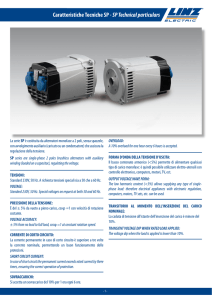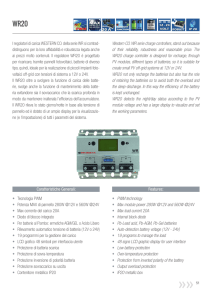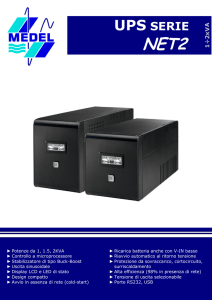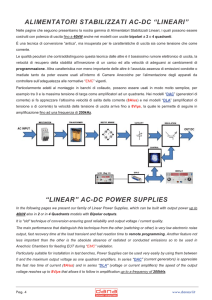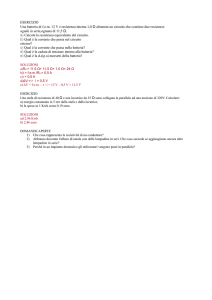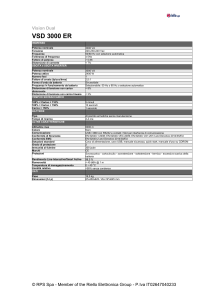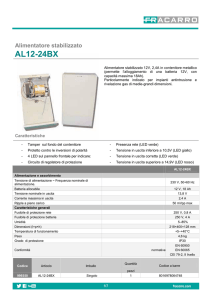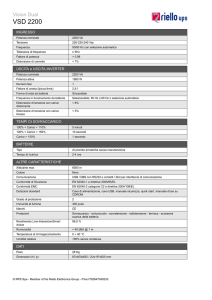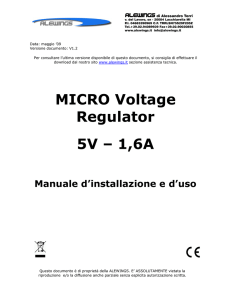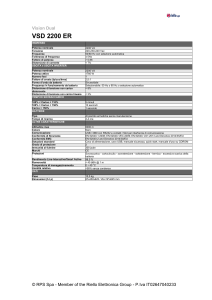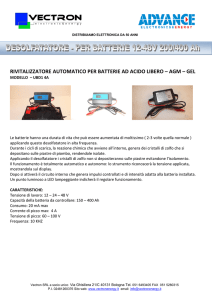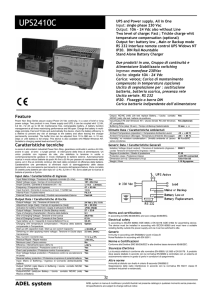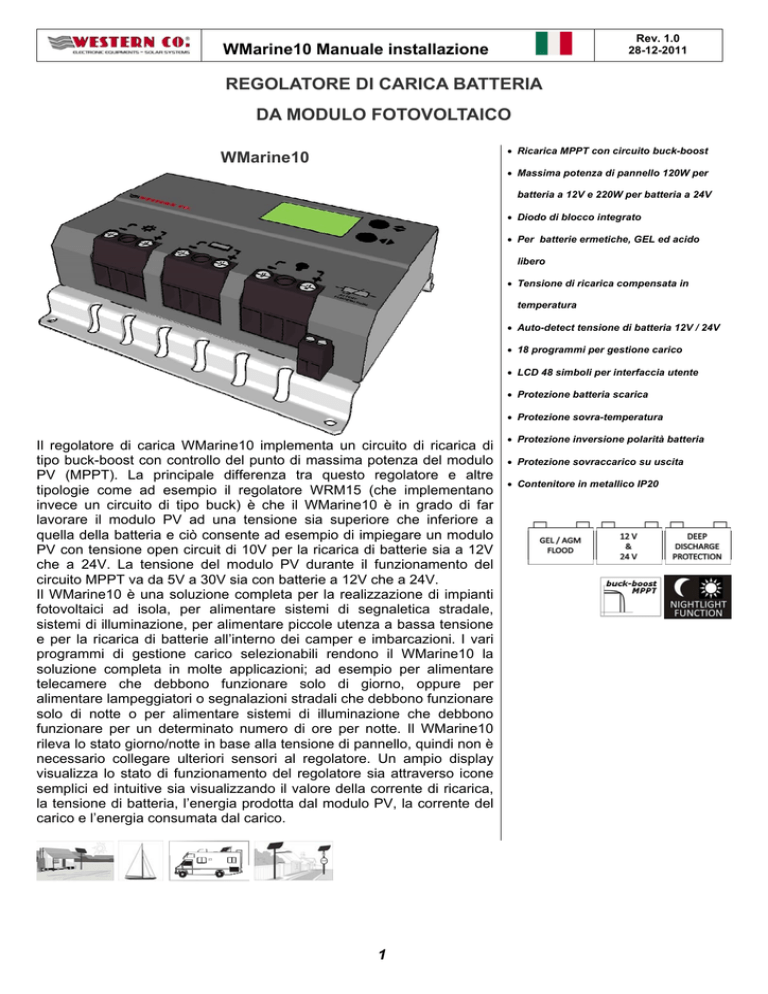
Rev. 1.0
28-12-2011
WMarine10 Manuale installazione
REGOLATORE DI CARICA BATTERIA
DA MODULO FOTOVOLTAICO
• Ricarica MPPT con circuito buck-boost
WMarine10
• Massima potenza di pannello 120W per
batteria a 12V e 220W per batteria a 24V
• Diodo di blocco integrato
• Per batterie ermetiche, GEL ed acido
libero
• Tensione di ricarica compensata in
temperatura
• Auto-detect tensione di batteria 12V / 24V
• 18 programmi per gestione carico
• LCD 48 simboli per interfaccia utente
• Protezione batteria scarica
• Protezione sovra-temperatura
Il regolatore di carica WMarine10 implementa un circuito di ricarica di
tipo buck-boost con controllo del punto di massima potenza del modulo
PV (MPPT). La principale differenza tra questo regolatore e altre
tipologie come ad esempio il regolatore WRM15 (che implementano
invece un circuito di tipo buck) è che il WMarine10 è in grado di far
lavorare il modulo PV ad una tensione sia superiore che inferiore a
quella della batteria e ciò consente ad esempio di impiegare un modulo
PV con tensione open circuit di 10V per la ricarica di batterie sia a 12V
che a 24V. La tensione del modulo PV durante il funzionamento del
circuito MPPT va da 5V a 30V sia con batterie a 12V che a 24V.
Il WMarine10 è una soluzione completa per la realizzazione di impianti
fotovoltaici ad isola, per alimentare sistemi di segnaletica stradale,
sistemi di illuminazione, per alimentare piccole utenza a bassa tensione
e per la ricarica di batterie all’interno dei camper e imbarcazioni. I vari
programmi di gestione carico selezionabili rendono il WMarine10 la
soluzione completa in molte applicazioni; ad esempio per alimentare
telecamere che debbono funzionare solo di giorno, oppure per
alimentare lampeggiatori o segnalazioni stradali che debbono funzionare
solo di notte o per alimentare sistemi di illuminazione che debbono
funzionare per un determinato numero di ore per notte. Il WMarine10
rileva lo stato giorno/notte in base alla tensione di pannello, quindi non è
necessario collegare ulteriori sensori al regolatore. Un ampio display
visualizza lo stato di funzionamento del regolatore sia attraverso icone
semplici ed intuitive sia visualizzando il valore della corrente di ricarica,
la tensione di batteria, l’energia prodotta dal modulo PV, la corrente del
carico e l’energia consumata dal carico.
1
• Protezione inversione polarità batteria
• Protezione sovraccarico su uscita
• Contenitore in metallico IP20
Rev. 1.0
28-12-2011
WMARINE10 Manuale installazione
Descrizione generale
WMarine10 è un regolatore di carica da moduli fotovoltaici per batterie elettrochimiche al piombo di tipo
ermetico (SEAL) o ad acido libero (FLOOD). In fig. 1 è riportato uno schema di principio del WMarine10.
IPAN
VPAN
Icharge
Buck-bust
converter
1
ILOAD
VBATT
2
3
MICRO CONTROLLER
Fig. 1 Schema di principio
1- Circuito di ricarica: adatta la VPAN e la IPAN (rispettivamente tensione e corrente del modulo fotovoltaico) in
modo da ricercare la condizione in cui la potenza erogata dal modulo PV è massima, realizzando quello
che nella letteratura tecnica è indicato con la sigla MPPT (Maximum Power Point Tracking). Inoltre gestisce
la ricarica della batteria riducendo la corrente erogata verso la batteria nelle condizioni in cui la tensione
VBATT supera la sua tensione di ricarica (Vch).
2- Circuito per il controllo del carico: accende/spegne il carico secondo il programma impostato dall’utente e
provvede al distacco del carico in caso di batteria scarica o sovraccarico o cortocircuito sul carico.
3- Microprocessore: controlla l’intero circuito, misura le correnti e tensioni del modulo della batteria e del
carico e le visualizza sul display.
2
Rev. 1.0
28-12-2011
WMarine10 Manuale installazione
Schema di collegamento
Sezioni coppie di filo in rame raccomandate che garantiscono
caduta di tensione massima pari a 1.5% della tensione
nominale della batteria.
Minima distanza
>
10 Cm
2.5 mm2
4 mm2
6 mm2
10 mm2
5A
2.6
4.2
6.3
10.4
10 A
1.3
2.1
3.1
5.2
15 A
0.9
1.4
2.1
3.5
Max. distanza
coppia fili [m]
Corrente
Tensione nominale batteria 12V
Sezione filo
PV
MODULE
2.5 mm2
4 mm2
6 mm2
10 mm2
5A
5.2
8.4
12.5
20.9
10 A
2.6
4.2
6.3
10.4
15 A
1.7
2.8
4.2
7.0
Max. distanza
coppia fili [m]
Corrente
Tensione nominale batteria 24V
Sezione filo
LOAD
BATTERY
BATTERY
TEMPERATURE
Fig. 2 Schema di collegamento
1) Installare il WMarine10 in un luogo asciutto ed adeguatamente arieggiato, fissato su di una superficie non
infiammabile e posizionato in modo da lasciare uno spazio privo di ostacoli di almeno 10Cm nell’intorno del
dispositivo che ne permette il raffreddamento per convezione naturale dell’aria.
2) Collegare: il carico, la sonda per misura temperatura batteria (in dotazione), modulo PV e per ultimo la
batteria come nello schema fig. 2. Alla connessione della batteria il regolatore si accende e inizia a funzionare.
Impiegare sezioni di cavo appropriati come indicato nella tabella di fig. 2.
3) Il WMarine10 riconosce automaticamente la tensione nominale di batteria (12V o 24V) e adegua di
conseguenza le sue soglie di funzionamento. L’utente deve però configurare il tipo di batteria in uso per
adeguare la corretta tensione di ricarica (Vch ). Si deve impostare la configurazione SEAL se si usano batterie
ermetiche VRLA o di tipo GEL, mentre si deve scegliere la configurazione FLOOD se si usano batterie ad
acido libero (fig. 4).
4) Impostare il programma di gestione del carico adeguato alla propria applicazione (fig. 4).
Collaudo dell’impianto
Appena realizzati i collegamenti come in fig. 2 è necessario procedere al collaudo del sistema.
1) Con il modulo PV esposto al sole, verificare che il WMarine10 ricarica la batteria andando a leggere la
corrente di ricarica IPAN e IBAT (vedi fig. 3).
2) Per verificare se la sonda di temperatura della batteria è stata collegata correttamente verificare su LCD
che alla pagina temperatura di batteria sia visualizzato un valore di temperatura attendibile (fig. 3).
3) Verificare la corretta accensione del carico. Se il carico è acceso solo di notte è possibile simulare la notte
scollegando temporaneamente uno dei fili del modulo PV. Con il carico acceso, verificare la corrente da
questo assorbita leggendo nell’apposita pagina dell’LCD (fig. 3).
3
Rev. 1.0
28-12-2011
WMARINE10 Manuale installazione
Visualizzazioni
Visualizzato nelle sole schermate di configurazione
Protezione batteria scarica
Stato giorno/notte
Accensione carico
Indicazione assorbimento
corrente dal modulo PV
Indicazione assorbimento
corrente sul carico
Livello di tensione nella batteria
Indica quale programma di
ricarica è attualmente impostato
Visualizza le misure interne
Pagina principale.
Visualizza la tensione di batteria (VBAT), il
programma di ricarica attualmente selezionato
(SEAL oppure FLOOD), lo stato giorno/notte
rilevato dal modulo PV e l’icona del carico, se
accesa, indica che il carico è alimentato.
Configurazione del sistema
Si accede alle pagine di configurazione del
WMarine10
mantenendo
premuti
contemporaneamente per almeno 2 secondi i tasti
.
Tasto
Visualizza la corrente (IPAN) del modulo PV.
Ricordiamo che la corrente erogata dal modulo
PV dipende dallo stato di soleggiamento dello
stesso e dallo stato di carica della batteria. Con la
batteria carica (Vbatt>14,4V @12V o Vbatt>28,8V
@24V) anche con un buon soleggiamento del
modulo si hanno basse correnti dal modulo PV in
quanto il regolatore limita la corrente per evitare
sovraccarico della batteria.
Pagina configurazione programma di ricarica
Imposta la tensione di ricarica per la batteria.
Si consiglia di impostare il programma SEAL
per batterie ermetiche o al gel, invece il
programma FLOOD per la ricarica di batteria
ad acido libero. Le tensioni di ricarica relative
a ciascuno dei programmi sono indicate nelle
successive fig. 6/8 e vanno scelti in accordo
con le indicazioni del costruttore della
batteria.
Tasto
Tensione del modulo PV (VPAN).
cambio pagina
Pagina Configurazione tensione di Low Battery
Imposta la tensione di intervento della
protezione di Low battery (distacco del carico
in caso di batteria scarica). Alla pressione del
si modifica l’impostazione da 10.8V a
tasto
12.2V per sistemi a 12V e da 21.6V a 24.4V
per sistemi a 24V.
cambio pagina
Pagina Configurazione programma gestione carico
Tasto
Visualizza la potenza in watt attualmente erogata
dal modulo PV.
Tasto
Visualizza il contatore dell’energia erogata dal
pannello in KWh. E’ possibile azzerare questa
misura premendo contemporaneamente i pulsanti
.
.
per 2 secondi.
carico
carico
sempre
acceso sia di acceso solo
giorno.
giorno sia di di
Tasto
Visualizza la corrente di ricarica in batteria
(ICHARGE).
carico
acceso solo
carico acceso
di notte per 1
di notte.
ora.
notte.
Visualizza
la
temperatura
della
batteria
attualmente misurata dalla sonda di temperatura
collegata al WMARINE10.
cambio pagina
Pagina visualizzazione versione software
Tasto
Visualizza la corrente attualmente erogata al
carico; anche se in questa schermata compare
accesa l’icona dal carico non è detto che questo
sia effettivamente alimentato, infatti il carico è
controllato secondo il programma di gestione
carico attualmente impostato .
Visualizza la versione software in uso su
WMARINE10
Tasto
Alla pressione del tasto si ritorna nella pagina configurazione
programma di ricarica
Visualizza la potenza attualmente erogata al
carico in watt.
Fig. 4 Pagine impostazioni
Una volta modificate le impostazioni del WMarine10
queste diventano operative solo dopo essere usciti
dalla pagine di configurazione mantenendo premuti
contemporaneamente per almeno 2 secondi i tasti
.
Tasto
E’ visualizzato il contatore dell’energia in KWh
consumati dal carico. E’ possibile azzerare questo
contatore premendo contemporaneamente i
Tasto
ore.
cambio pagina
Pagina Configurazione tensione Vday
Il WMARINE10 rileva che è giorno quando la
tensione del modulo PV (VPAN) è maggiore
della soglia VDAY, invece rileva che è notte
quando la VPAN è minore della soglia VNIGHT. In
questa pagina è possibile modificare la soglia
VDAY . La soglia VNIGHT = VDAY –1.3V
Tasto
pulsanti
carico
acceso
di
notte per 16
per 2 secondi.
Alla pressione del tasto si ritorna alla pagina
principale.
Fig. 3 Pagine visualizzazioni misure
4
Rev. 1.0
28-12-2011
WMARINE10 Manuale installazione
Codici di errore
All’intervento delle protezioni interne del WMarine10 compaiono dei codici di errore come riportato di seguito.
Tabella codice errore
Intervenuta protezione di sovraccarico. La corrente
del carico ha superato il limite massimo consentito
per il WMarine10 (Iload nella tabella caratteristiche
elettriche) e il regolatore ha distaccato il carico per
prevenire rotture interne. Nel caso intervenga
questa segnalazione è necessario verificare se la
corrente assorbita dal carico è inferiore al limite
consentito. Dopo 1 minuto il WMarine10 tenta di
alimentare nuovamente il carico e esce da questo
stato se è sta eliminata la causa che ha generato il
sovraccarico.
Il simbolo low battery lampeggiante indica
che è intervenuta la protezione di batteria
scarica e quindi per preservare la vita della
batteria è stato disconnesso il carico.
Questa protezione interviene quando la
tensione di batteria scende sotto la soglia
VLB impostabile dall’utente (fig. 4). Il
WMarine10 esce da questa protezione
quando la batteria sarà ricaricata dal
modulo PV alla tensione VOUT-LB (vedi Fig.8
tabella caratteristiche elettriche).
E’ stata connessa la batteria con polarità
invertite. Rivedere il collegamento elettrico
della batteria.
Interviene quando la temperatura interna
del WMarine10 supera gli 80°C e disattiva
la ricarica. Si esce automaticamente da
questa protezione quando la temperatura
interna scende al di sotto della soglia di
50°C. (nota la temperatura interna al
regolatore non è visualizzata nell’LCD).
Qualora
intervenga
spesso
questa
protezione consigliamo di alloggiare il
regolatore in un luogo più fresco.
Interviene questa segnalazione quando la tensione
di batteria è inferiore a 9.0V. In queste condizioni è
disabilitata la ricarica.
Fig. 5 Tabella codici errore
Tensione fine carica in funzione della temperatura sistema a
16,0 12V
32,0
FLOOD
Tensione fine carica in funzione della temperatura sistema a 24V
SEAL
31,5
Tensione fina carica Volt
Tensione fina carica Volt
SEAL
15,5
15,0
14,5
14,0
FLOOD
31,0
30,5
30,0
29,5
29,0
28,5
28,0
27,5
27,0
13,5
-10 -5
0
5
-10
10 15 20 25 30 35 40 45 50 55 60
Temperatura °C
-5
0
5
10
15
20
25
30
35
Temperatura °C
Fig. 6 Curva di compensazione della tensione di ricarica Vch in funzione della temperatura di batteria
5
40
45
50
55
60
Rev. 1.0
28-12-2011
WMARINE10 Manuale installazione
CARATTERISTICHE ELETTRICHE
Tensione di batteria
Tensione di pannello a circuito aperto
Massima potenza di pannello
Tensione uscita carico
Vbatt
Vpan
Pmax
Vload
Tensione nominale batteria 12V
Tensione nominale batteria 24V
Min
10V
5V
-
Max
16V
40V
120W
Tensione di batteria
15A
14.4V
14.8V
-24mV/°C
-
Min
20V
5V
-
11.4V
(default)
13.4V
13.8V
4.4V
(default)
12.7mA
12.2V
21.6V
9.6V
1.9V
8.3V
0.6V
40°C
20 W
2
10mm
-10°C
-
-
Tip
Corrente del carico
Iload
Tensione di ricarica a 25°C programma SEAL (default)
Vch
Tensione di ricarica a 25°C programma FLOOD
Vch
Compensazione della Vch funzione della temperatura di batteria Vtadj
(Tbatt)
Tensione di low battery (impostabile)
Vlb
-
Tensione uscita low battery a 25°C programma SEAL
Tensione uscita low battery a 25°C programma FLOOD
Tensione rilevazione giorno (impostabile)
Vout_lb
Vout_lb
Vday
1.9V
Tensione rilevazione notte: Vnight = Vday –1.3V
Auto consumo
Vnight
Isleep
0.6V
Temperatura di esercizio
Potenza dissipata
Sezione ai morsetti
Grado di protezione
Peso
Tamb
Pdiss
-10°C
10.8V
Tip
Max
32V
40V
220W
Tensione di batteria
15A
28.8V
29.6V
-48mV/°C
-
-
-
(Vbat 14,0V)
1mm
2
IP20
515 g
Fig. 8 Tabella caratteristiche elettriche
Dimensioni
Fig. 8 Dimensioni
6
22.8V
(default)
27.8V
28.6V
4.4V
(default)
17,7mA
24.4V
9.6V
8.3V
(Vbat 28,0V)
1mm
40°C
29 W
2
10mm
2
IP20
515 g
-
WMARINE10 Manuale installazione
Rev. 1.0
28-12-2011
Garanzia di legge
Western Co srl garantisce la buona qualità e la buona costruzione dei Prodotti obbligandosi, durante il periodo
di garanzia di 2 (due) anni, a riparare o sostituire a sua sola discrezione, gratuitamente, quelle parti che, per
cattiva qualità del materiale o per difetto di lavorazione si dimostrassero difettose.
Il prodotto difettoso dovrà essere rispedito alla Western Co srl o a società delegata dalla Western Co srl a fare
assistenza sul prodotto, a spese del cliente, assieme ad una copia della fattura di vendita, sia per la
riparazione che la sostituzione garantita. I costi di re-installazione del materiale saranno a carico del cliente.
La Western Co srl sosterrà le spese di re spedizione del prodotto riparato o sostituito.
La garanzia non copre i Prodotti che, in base a nostra discrezione, risultino difettosi a causa di
naturale logoramento, che presentino guasti causati da imperizia o negligenza del cliente, da
imperfetta installazione, da manomissioni o interventi diversi dalle istruzioni da noi fornite .
La garanzia decade altresì in caso di danni derivanti da:
-trasporto e/o cattiva conservazione del prodotto.
-causa di forza maggiore o eventi catastrofici (gelo per temperature inferiori a -20°C, incendio, inondazioni,
fulmini, atti vandalici, ecc…).
Tutte le sopraccitate garanzie sono il solo ed esclusivo accordo che soprassiede ogni altra
proposta o accordo verbale o scritto e ogni altra comunicazione fatta tra il produttore e l’acquirente
in rispetto a quanto sopra.
Per qualsiasi controversia il Foro competente è Ascoli Piceno.
Smaltimento dei rifiuti
La Western Co in qualità di produttore del dispositivo elettrico descritto nel
presente manuale, ed in conformità al D.L 25/07/05 n 151, informa l’acquirente
che questo prodotto, una volta dismesso, deve essere consegnato ad un
centro di raccolta autorizzato oppure, in caso di acquisto di apparecchiatura
equivalente può essere riconsegnato a titolo gratuito al distributore della
apparecchiatura nuova.
Le sanzioni per chi abusivamente si libera di un rifiuto elettronico saranno
applicate dalle singole amministrazioni comunali.
WESTERN CO. srl
Via Pasubio 1
63074 San Benedetto del Tronto (AP)
tel 0735 751248 fax 0735 751254
e-mail: [email protected]
web: www.western.it
7
WMARINE10 – Technical Manual
Rev. 1.0
28-12-2011
PHOTOVOLTAIC CHARGE REGULATOR
• MPPT charge with buck-boost circuit
WMarine10
• Max PV module power: 120W for 12V
battery and 220W for 24V battery
• Integrated blocking diode
• For sealed, GEL and flooded lead acid
batteries
• Charge voltage compensated in
temperature
• Auto-detect of battery voltage: 12V / 24V
• 18 programs for load management
• LCD with 48 symbols for user interface
• Low battery protection
• Over temperature protection
WMarine10 has got a buck-boost charge circuit with control of the
maximum power point of the PV module (MPPT). The main difference
between this controller and other types with buck circuit (as for instance
WRM15) is that WMarine10 is able to allow the working of the PV
module at a voltage than can be either higher or lower than that of
battery; this allows, for example, to use a PV module with open circuit
voltage of 10V for the charge of batteries both at 12V and 24V.
PV module voltage during the working of MPPT circuit goes from 5V to
40V with both 12V and 24V batteries.
WMarine10 is a complete solution for the realization of off-grid PV
systems, to power supply road signs systems, lighting systems, small
low voltage systems and for the charge of batteries inside caravans and
boats.
The several programs of load management, selectable by the user,
make WMarine10 the proper solution in several applications; i.e. to
power supply video cameras that have to work only during the day, or to
power supply flashing systems/road signs that have to work only during
night or to power supply lighting systems that have to work only for a
certain number of hours during night. WMarine10 detects the day/night
status according to the PV module’s voltage; therefore it is not
necessary to connect further sensors to the regulator. A wide display
shows the working status of the regulator either through simple and
intuitive icons or displaying the values of charge current, battery voltage,
energy produced by the PV module, load current and energy consumed
by the load.
8
• Protection for battery polarity inversion
• Overload protection on output
• IP20 metal box
Rev. 1.0
28-12-2011
WMarine10 – Technical Manual
General description
WMarine10 is a photovoltaic charge regulator for leaden electrochemical batteries either sealed (SEAL) or
flooded lead acid (FLOOD). In fig. 1 there is a scheme principle of WMarine10.
IPAN
VPAN
Icharge
Buck-bust
converter
1
ILOAD
VBATT
2
3
MICRO CONTROLLER
Fig. 1 Block diagram
4- Charge circuit: it adapts VPAN and IPAN (respectively voltage and current of the PV module) so to search the
condition in which the power that is given by the PV module is maximum, thus realizing the MPPT
(Maximum Power Point Tracking). In addition, it manages the battery charge by reducing the current sent
towards the battery when the battery VBATT exceeds its charge voltage (Vch).
5- Circuit for load control: it turns on/off the load according to the program set by the user and it provides to
load detachment in case of discharged battery, overload or short-circuit on the load.
6- Microprocessor: it controls the whole circuit, it measures currents and voltages of PV module, battery and
load and it shows them on the display.
9
Rev. 1.0
28-12-2011
WMARINE10 – Technical Manual
Wiring scheme
Recommended pairs of copper wire that guarantee a maximum
voltage drop of 1.5% of the battery nominal voltage.
Minimum dis tanc e
>
10 Cm
2.5 mm 2
4 mm 2
6 mm 2
10 mm 2
5A
2.6
4.2
6.3
10 .4
10 A
1.3
2.1
3.1
5.2
15 A
0.9
1.4
2.1
3.5
Max. length
wires couple [m ]
Current
12V batte ry nomi nal voltage
Wire section
PV
MODULE
2.5 mm 2
4 mm 2
6 mm 2
10 mm 2
5A
5.2
8.4
12.5
20 .9
10 A
2.6
4.2
6.3
10 .4
15 A
1.7
2.8
4.2
7.0
Max. length
wires couple [m ]
Current
24V ba tte ry nomi nal vo ltage
Wire section
LOAD
BATTERY
BA TTERY
TEMPER ATURE
Fig. 2 Wiring scheme
1) Install WMarine10 in a dry and adequately ventilated place; it has to be fixed on a non-flammable surface
and placed so to leave an unobstructed space of at least 10cm around the device that allows the cooling by
natural air convection.
2) Connect respectively: load, sensor for battery temperature measure (supplied), PV module and, last, the
battery as in the scheme fig. 2. When you connect the battery the regulator turns on and it begins to work.
Use proper cable sections as indicated in fig. 2.
3) WMarine10 recognizes automatically the battery nominal voltage (12V or 24V) and it adapts consequently
its working thresholds. The user must configure the kind of battery in use to adequate the right charge voltage
(Vch ). You have to set SEAL configuration if you use VRLA or GEL sealed batteries, while you have to choose
FLOOD configuration if you use flooded lead acid batteries (fig. 4).
4) Set the proper load management program to your own application (fig. 4).
Testing
Once made the connections as in fig. 2 it is necessary to proceed with the testing of the system.
1) With the PV module exposed to sunrays, verify that WMarine10 is charging the battery reading the values of
charge current IPAN and IBAT (see fig. 3).
2) To verify that the battery temperature sensor has been properly connected, check on the LCD that at the
page “battery temperature” a reliable temperature value is displayed (fig. 3).
3) Verify the correct turning on of the load. If the load is ON only during night it is possible to simulate the night
by disconnecting temporarily one of the wires of the PV module. With load ON, check the absorbed current by
reading in the proper page of LCD (fig. 3).
10
Rev. 1.0
28-12-2011
WMarine10 – Technical Manual
Visualizations
On ly di sp layed i n the con figu ratio n scre ens
Lo w bat tery prot ecti on
Day/n igh t statu s
Load turn ing o n
I ndi cat ion o f cur rent
ab so rpti on from th e PV
mo dul e
In dicati on of curr ent
absor ption on th e load
Vo ltage l evel i nside th e batter y
It ind icates whi ch charg e
prog ram is cu rren tly se t
It di sp lays i ntern al measur es
Main page.
It displays the battery voltage (VBAT), the charge
program currently selected (SEAL or FLOOD), the
day/night status detected by the PV module. The
load icon, if ON, indicates that the load is power
supplied.
System configuration
You can go to the configuration pages of
WMarine10 pressing simultaneously for at least 2
seconds the buttons
.
button
Charge program configuration page
It displays the current (IPAN) of the PV module. We
remember that the current delivered by the PV
module depends on its state of sun-lighting and on
battery charge status. With charged battery
(Vbatt>14,4V @12V or Vbatt>28,8V @24V) even
with a good lighting of the PV module, you have
low currents from PV module since the regulator
limits the current to avoid battery overcharge.
It sets the charge voltage for the battery.
We recommend to set the SEAL program for
GEL or sealed batteries and the FLOOD
program for the charge of flooded lead acid
batteries. Charge voltages relating to each
one of the programs are indicated in the
following fig. 6/8 and must be chosen in
accordance with the battery manufacturer
indications.
button
PV module voltage (VPAN).
Page change
Low Battery voltage configuration page
It sets the intervention voltage of Low battery
protection (load detachment in case of low
you
battery). When pressing the button
change the setting from 10.8V to 12.2V for
12V systems and from 21.6V to 24.4V for 24V
systems.
button
It displays the power in watt actually delivered by
the PV module.
Page change
Load management program configuration page
button
It displays the counter of energy that is delivered
by the PV module in KWh. It is possible to reset
this measure pressing simultaneously the buttons
.
.
for 2 seconds.
Load always
ON Load
ON Load
ON
either Load
during
during day or only during only during
for 1
during night. day.
night.
button
It displays the charge current inside the battery
(ICHARGE).
It displays the battery temperature that is currently
measured by the temperature sensor connected
to WMARINE10.
button
It displays the current that is currently delivered to
the load; even if in this screen the load icon is on,
this does not mean that it is effectively power
supplied; in fact the load is controlled according to
the load management program that is currently
set.
It displays the
WMARINE10
software version in use on
Pressing the left button you go back to the configuration page of the
charge program
button
It displays the power that is currently delivered to
the load in watt.
Fig. 4 Setting pages
Once modified the settings of WMarine10 these
become operative only after editing from the
configuration pages pressing simultaneously the
buttons
for at least 2 seconds.
button
It displays the energy counter in KWh consumed
by the load. It is possible to reset this counter
button
Load
ON
during night
for 16 hours.
Page change
Voltage configuration page - Vday
WMARINE10 detects the day when the
voltage of PV module (VPAN) is > than VDAY
threshold; it detects the night when VPAN is <
than VNIGHT threshold. In this page it is
possible to change VDAY threshold.
VNIGHT threshold = VDAY –1.3V
Page change
Software version display page
button
pressing simultaneously the buttons
seconds.
ON
night
hour.
for 2
Pressing the button you go back to the main page.
Fig. 3 Display pages of measures
11
Rev. 1.0
28-12-2011
WMARINE10 – Technical Manual
Error codes
With the intervention of del WMarine10 internal protections, there are the below reported error codes.
Table of Error code
Overload protection occurred. The load current
exceeded the maximum allowed limit for
WMarine10 (Iload in the “Table of electrical
features”) and the regulator detached the load to
prevent internal damages. If there is such a
signalling, it is necessary to check if the current
absorbed by the load is < than the allowed limit.
After 1 minute WMarine10 tries to power supply
again the load. It exits from this condition if the
cause that generated the overload has been
eliminated.
When low battery symbol is flashing this
indicates that there is the low battery
protection - load has been disconnected to
preserve battery life. This protection
intervenes when the battery voltage goes
under VLB threshold that can be set by the
user (fig. 4). WMarine10 leaves this
protection when the battery will be charged
by the PV module at VOUT-LB voltage (see
Fig. 8 “Table of electrical features”).
The battery was connected with inverted
polarities. Check the electrical connections
of the battery.
You have this error when internal
temperature of WMarine10 exceeds 80°C
and deactivates the charge. You exit
automatically from this protection when the
internal temperature goes below the
threshold of 50°C (note: the internal
temperature of the regulator is not
displayed on the LCD). If you see often this
protection we advise to place the regulator
in a cooler place.
You have this error when the battery voltage is <
than 9.0V. In these conditions, the charge is
disabled.
Fig. 5 Table of error codes
16,0
End-charge voltage according to temperature - 12V system
32,0
FLOOD
15,5
15,0
14,5
14,0
End-charge voltage according to temperature - 24V system
SEAL
31,5
End-charge voltage - Volt
End-charge voltage - Volt
SEAL
FLOO D
31,0
30,5
30,0
29,5
29,0
28,5
28,0
27,5
27,0
13,5
-10 -5
0
5
-10
10 15 20 25 30 35 40 45 50 55 60
Temperature °C
-5
0
5
10
15
20
25
30
Temperature °C
Fig. 6 Compensation curve of Vch charge voltage according to battery temperature
12
35
40
45
50
55
60
Rev. 1.0
28-12-2011
WMARINE10 – Technical Manual
ELECTRICAL FEATURES
12V battery nominal voltage
Min
10V
5V
-
Battery voltage
Open circuit voltage of PV module
Max PV module power
Load output voltage
Vbatt
Vpan
Pmax
Vload
Load current
Charge voltage at 25°C - SEAL program (default)
Charge voltage at 25°C - FLOOD program
Vch compensation according to battery temperature (Tbatt)
Low battery voltage (it can be set)
Iload
Vch
Vch
Vtadj
Vlb
-
Output voltage from low battery at 25°C - SEAL program
Output voltage from low battery at 25°C - FLOOD program
Solar modules threshold voltage for day detection (settable)
Vout_lb
Vout_lb
Vday
1.9V
Solar modules threshold voltage for night detection:
Vnight = Vday –1.3V
Self consumption
Vnight
0.6V
Operating Temperature
Dissipated power
Terminals section
IP protection degree
Weight
Tip
Battery
voltage
10.8V
Isleep
Tamb
Pdiss
14.4V
14.8V
-24mV/°C
11.4V
(default)
13.4V
13.8V
4.4V
(default)
-
Fig. 8 Dimensions
13
Tip
15A
-
12.2V
21.6V
9.6V
1.9V
8.3V
0.6V
Battery
voltage
28.8V
29.6V
-48mV/°C
22.8V
(default)
27.8V
28.6V
4.4V
(default)
-
12.7mA
17,7mA
(Vbat 28,0V)
2
IP20
515 g
Fig. 8 Table of electrical features
Dimensions
Min
20V
5V
-
(Vbat 14,0V)
-10°C
1mm
24V battery nominal voltage
Max
16V
40V
120W
-
40°C
20 W
2
10mm
-10°C
-
-
1mm
Max
32V
40V
220W
15A
24.4V
9.6V
8.3V
40°C
29 W
2
10mm
2
IP20
515 g
-
WMARINE10 – Technical Manual
Rev. 1.0
28-12-2011
Warranty
Western Co. Srl guarantees the good quality and manufacturing of its products obliging itself, during the
warranty period of 2 (two) years, to repair or replace at its sole discretion, for free, those parts that are
defective owing to poor quality material or workmanship defect.
The defective product must be returned to Western Co Srl by a delegated company for assistance, at the
expense of the customer, along with a copy of the sales invoice, both for repairing and guaranteed
replacement. The costs of re-installation of the material will be borne by the customer.
Western Co srl will pay the transport expenses for the shipment of the repaired/replaced product.
Warranty does not cover Products that, according to our discretion:
- are defective owing to natural wear,
- have failures caused by malpractice or negligence of the customer, by incorrect installation, by
tampering or interventions that are different from the instructions supplied by us.
Warranty is void if damage is also caused by:
- transport and/or bad storage of the product.
- force majeure or catastrophic events (frost for temperatures < -20°C, fire, flooding, lightning, vandalism, and
so on).
All the above guarantees are the sole and exclusive agreement which supersedes any proposal
or agreement whether written or oral and any other communication made between the producer and the
purchaser with respect to the above. For any dispute the jurisdiction is Ascoli Piceno (Italy).
Disposal of waste
Western Co., as a producer of electrical device herein described and in
accordance with Law No. 151 25/07/05, informs the buyer that this product,
once divested, must be delivered to an authorized recycling center or, in case
of purchase of equivalent equipment, it may be returned at no cost to the
distributor of the new equipment. Penalties for those who get rid of an
electronic waste will be used by individual municipalities.
WESTERN CO. srl
Via Pasubio 1
63074 San Benedetto del Tronto (AP) - Italy
tel + 39 0735 751248 fax +39 0735 751254
e-mail: [email protected]
web: www.western.it
14

